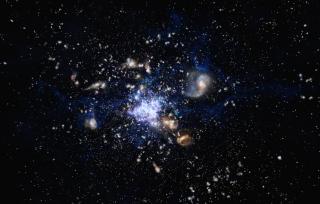Bibcode
Zavala, J. A.; Casey, C. M.; Scoville, N.; Champagne, J. B.; Chiang, Y.; Dannerbauer, H.; Drew, P.; Fu, H.; Spilker, J.; Spitler, L.; Tran, K. V.; Treister, E.; Toft, S.
Referencia bibliográfica
The Astrophysical Journal
Fecha de publicación:
12
2019
Revista
Número de citas
54
Número de citas referidas
51
Descripción
We present ALMA Band 6 (ν = 233 GHz, λ = 1.3 mm) continuum observations toward 68 “normal” star-forming galaxies within two Coma-like progenitor structures at z = 2.10 and 2.47, from which ISM masses are derived, providing the largest census of molecular gas mass in overdense environments at these redshifts. Our sample comprises galaxies with a stellar mass range of 1 × 109 M ☉─4 × 1011 M ☉ with a mean M ⋆ ≈ 6 × 1010 M ☉. Combining these measurements with multiwavelength observations and spectral energy distribution modeling, we characterize the gas mass fraction and the star formation efficiency, and infer the impact of the environment on galaxies’ evolution. Most of our detected galaxies (≳70%) have star formation efficiencies and gas fractions similar to those found for coeval field galaxies and in agreement with the field scaling relations. However, we do find that the protoclusters contain an increased fraction of massive, gas-poor galaxies, with low gas fractions (f gas ≲ 6%─10%) and red rest-frame ultraviolet/optical colors typical of post-starburst and passive galaxies. The relatively high abundance of passive galaxies suggests an accelerated evolution of massive galaxies in protocluster environments. The large fraction of quenched galaxies in these overdense structures also implies that environmental quenching takes place during the early phases of cluster assembly, even before virialization. From our data, we derive a quenching efficiency of ∊ q ≈ 0.45 and an upper limit on the quenching timescale of τ q < 1 Gyr.
Proyectos relacionados

Gas Molecular y Polvo en Galacias através del Tiempo Cósmico
Dos cuestiones fundamentales en la Astrofísica son la conversión de gas molecuar en estrellas y cómo este proceso físico depende del entorno en todas las escalas, desde sistemas planetarios, cúmulos estelares, galaxias hasta cúmulos de galaxias. El objectivo principal de este proyecto es el de estudiar la formación y evolución de galaxias a partir
Helmut
Dannerbauer